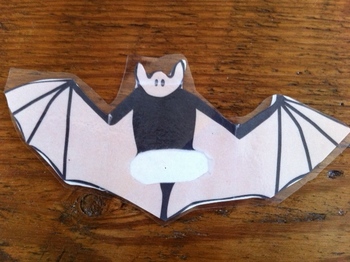 Today I'd like to draw your attention to the bat illustration in the photo. No, this is not a prehistoric European cave art replica. Nor is it the work of a small child. It is in fact something I created more than TWENTY years ago, that has been heartedly used by school children since it first appeared. I drew the original, that this photocopy is descended from, in a frenzy one spring morning, minutes before a busload of grade three students were to arrive and use them. Remember, this was before Google. I did not have the option to sort through hundreds of suitable images, select one and print multiple copies. What I did was, look at a picture from one of the many books I used to research the program, and drew this bad boy freehand. I then ran to the photocopier, made copies and cut out each bat with scissors. In the original image, the bat retained its thumbnails for anatomical correctness. You cannot see them here because I can only surmise some interpreter got lazy and lobbed them off. More likely, they were in the same hurry I was on the bats' birthday and desperately needed to finish a new batch for an imminent busload of students. This bat is a prop for a school program about bats and their habitats (aptly named Ha-BAT-itat, [thanks Mike McIntosh]) that I was piloting that morning while working in Vancouver's Stanley Park. The program ended up a success and very popular with teachers. Excellent! Years later, I adapted the program for CRD Parks on Vancouver Island. By now, thousands of children have traipsed through old growth forests with these little hand-bats, on their fingers (there are supposed to be two finger holes cut out where that white oval is on the bat in the picture) making the wings flap and looking for holes and crevices in big west coast trees where bats might roost or hibernate. On the surface, it may seem simple, but as an activity, it's got it all; think, feel and do. The little hand-bat acts as a search image, to help them look differently at the trees around them as potential homes for bats. Among several applications, math skills are used as kids are invited to estimate the number of bats that can fit in each roost site. No matter how careful I am to collect them all up, it is not uncommon after a day of bat programs to find a little bat, with its wings folded in, tucked in a Douglas-fir bark crevice upside down. All good. Love it. The thing is, this bat illustration, that I hurriedly drew and then madly photocopied and cut out that morning, was supposed to be replaced that very day, with the better, permanent version. One that I or someone else would carefully and lovingly draw. It never happened. There was always something more important to do. Deliver programs. Clean up deer mouse droppings. Fundraise for our wages. Even when I brought them across the ocean to Victoria, I meant to fix 'em up, but no, they were adopted here too as complete little beings. Recently I used the bats with a group of kids again and all I can see is the uneven dots for eyes, the wonky ears, lack of nose or or mouth and the unrealistic girth of the bat's chest. Am I going to redo the bat now? Of course not, and rob the children of the joy of their imagination? It's what I intended all along. I'm sure of it.
0 Comments
Your comment will be posted after it is approved.
Leave a Reply. |
Archives
May 2022
|
 RSS Feed
RSS Feed